Case Analysis: Diagnostic Approach to Chest Discomfort in John Smith
VerifiedAdded on 2022/11/28
|13
|3319
|325
Case Study
AI Summary
This case analysis focuses on John Smith, a 50-year-old Native American male presenting with chest discomfort, described as a burning sensation under the sternum. The paper conducts a thorough review of his clinical history, including past medical history of hypertension, hyperlipidemia, hypothyroidism, and diabetes Mellitus Type II, along with a sore on his right lower extremity. The analysis then formulates a primary hypothesis, considering both cardiac and digestive causes for the chest discomfort. The paper explores alternative hypotheses, including myocardial infarction, GERD, dyspepsia, H. pylori infection, and esophagitis, supported by evidence. It details the physical assessment signs supporting each differential diagnosis, prescribed diagnostic studies to evaluate each hypothesis, and strategies for including the patient and family to avoid diagnostic errors. Furthermore, it discusses the use of health IT resources to improve diagnostic accuracy, evaluating the implementation of these resources with evidence. Finally, the paper outlines appropriate pharmacologic interventions for each differential diagnosis, providing a comprehensive approach to John Smith's case.
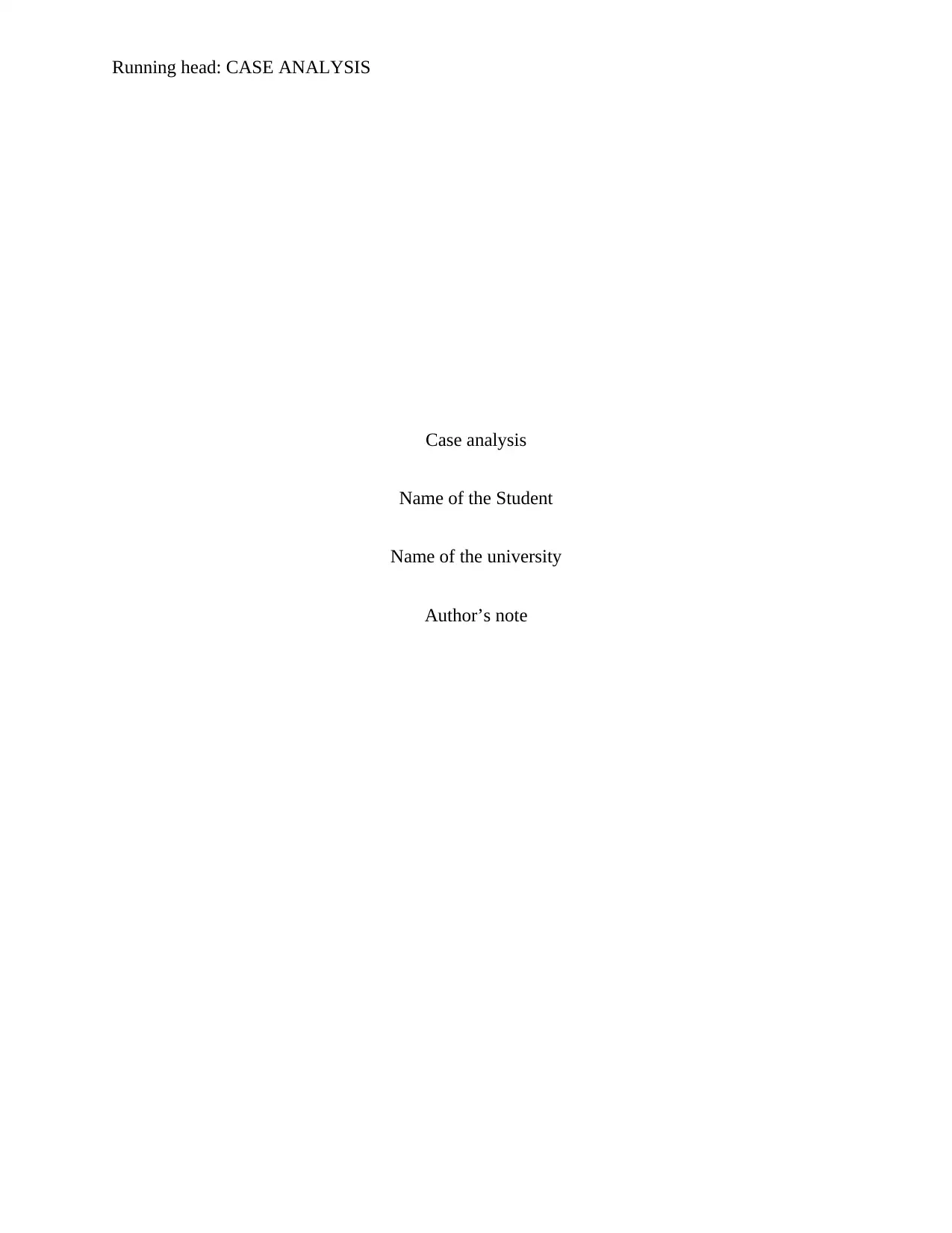
Running head: CASE ANALYSIS
Case analysis
Name of the Student
Name of the university
Author’s note
Case analysis
Name of the Student
Name of the university
Author’s note
Paraphrase This Document
Need a fresh take? Get an instant paraphrase of this document with our AI Paraphraser

1CASE ANALYSIS
The case study is about John Smith, a 50 year old Native American male who presented
to the hospital with chest discomfort. The main purpose of this paper is to conduct case analysis
and review clinical history and other data to select a primary and differential diagnosis. The
process will start with analysis of thorough direct clinical history.
Thorough directed clinical history:
The past medical history (PMH), past surgical history (PSH), review of systems (ROS)
and social history of Mr. John was considered to get idea about clinical history. The PHM data
shows that John has a history of hypertension, hypelipidemia, hypothyroidism and diabetes
Mellitus Type II. Hence, based on this information, the body systems that are affected by disease
include the endocrine system and circulatory system of patient is affected. Effect on the
endocrine system is seen due to hypothyroidism, whereas effect on circulatory system is seen
due to hypertension, diabetes and hypothyroidism. However, he has a sore on the right lower
extremity with draining purulent exudate. This might be due to infected wound or foot infection.
He has currently no medications available. Although the social history data for client is not
provided, however collecting data related to social history is important to determine the kind of
social support available to student and know about other lifestyle patterns and other cultural
details of patient (Oyedokun, Adeloye & Balogun, 2016).
Evidence-supported primary hypothesis for a differential diagnosis:
Based on the review of current symptoms and past clinical history of John, the primary
hypothesis for Mr. John is that chest pain and burning sensation under the sternum might be
occurring due to heart related causes or digestive causes. Heart related problems like
development of myocardial infarction and angina are the common cause behind chest discomfort
The case study is about John Smith, a 50 year old Native American male who presented
to the hospital with chest discomfort. The main purpose of this paper is to conduct case analysis
and review clinical history and other data to select a primary and differential diagnosis. The
process will start with analysis of thorough direct clinical history.
Thorough directed clinical history:
The past medical history (PMH), past surgical history (PSH), review of systems (ROS)
and social history of Mr. John was considered to get idea about clinical history. The PHM data
shows that John has a history of hypertension, hypelipidemia, hypothyroidism and diabetes
Mellitus Type II. Hence, based on this information, the body systems that are affected by disease
include the endocrine system and circulatory system of patient is affected. Effect on the
endocrine system is seen due to hypothyroidism, whereas effect on circulatory system is seen
due to hypertension, diabetes and hypothyroidism. However, he has a sore on the right lower
extremity with draining purulent exudate. This might be due to infected wound or foot infection.
He has currently no medications available. Although the social history data for client is not
provided, however collecting data related to social history is important to determine the kind of
social support available to student and know about other lifestyle patterns and other cultural
details of patient (Oyedokun, Adeloye & Balogun, 2016).
Evidence-supported primary hypothesis for a differential diagnosis:
Based on the review of current symptoms and past clinical history of John, the primary
hypothesis for Mr. John is that chest pain and burning sensation under the sternum might be
occurring due to heart related causes or digestive causes. Heart related problems like
development of myocardial infarction and angina are the common cause behind chest discomfort
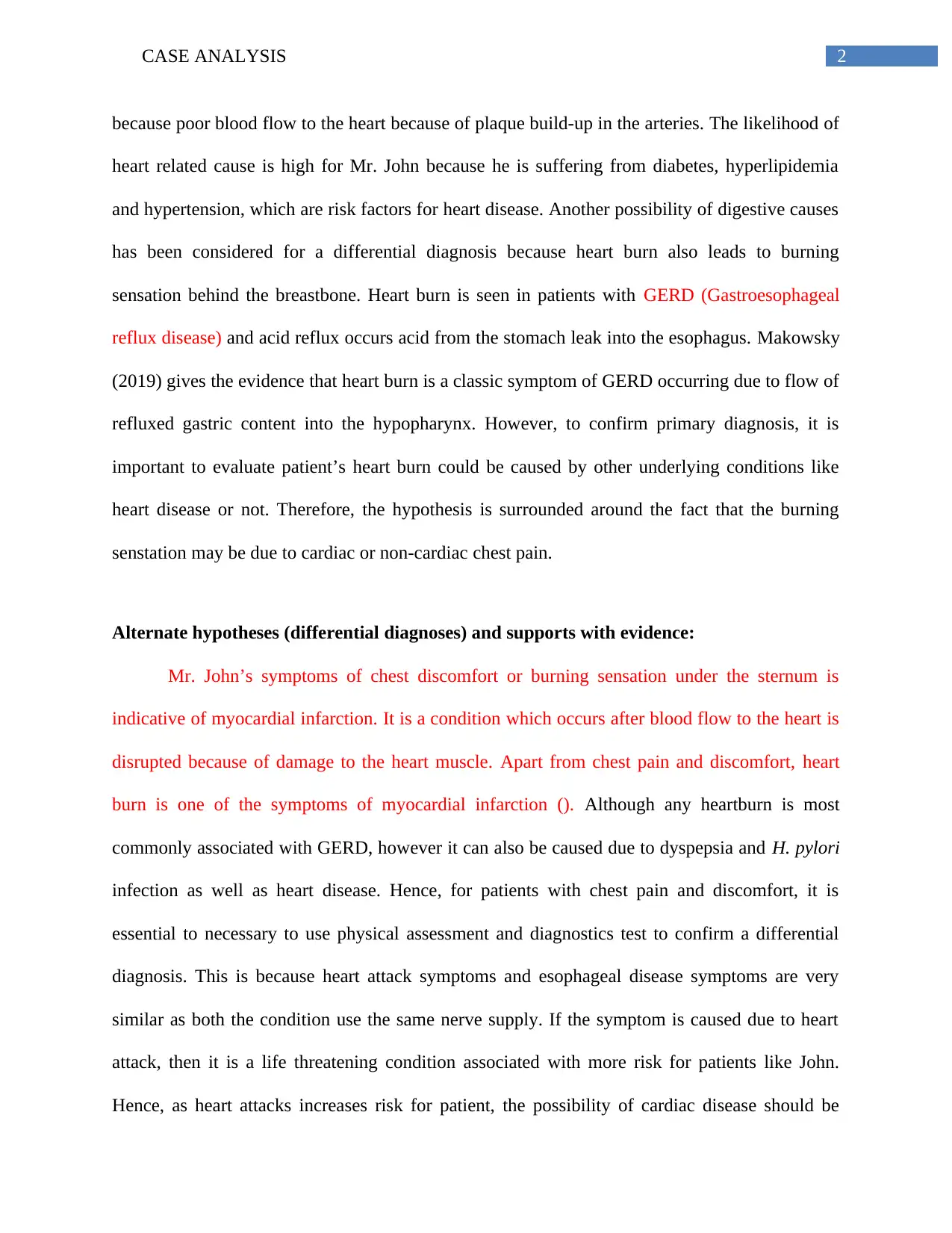
2CASE ANALYSIS
because poor blood flow to the heart because of plaque build-up in the arteries. The likelihood of
heart related cause is high for Mr. John because he is suffering from diabetes, hyperlipidemia
and hypertension, which are risk factors for heart disease. Another possibility of digestive causes
has been considered for a differential diagnosis because heart burn also leads to burning
sensation behind the breastbone. Heart burn is seen in patients with GERD (Gastroesophageal
reflux disease) and acid reflux occurs acid from the stomach leak into the esophagus. Makowsky
(2019) gives the evidence that heart burn is a classic symptom of GERD occurring due to flow of
refluxed gastric content into the hypopharynx. However, to confirm primary diagnosis, it is
important to evaluate patient’s heart burn could be caused by other underlying conditions like
heart disease or not. Therefore, the hypothesis is surrounded around the fact that the burning
senstation may be due to cardiac or non-cardiac chest pain.
Alternate hypotheses (differential diagnoses) and supports with evidence:
Mr. John’s symptoms of chest discomfort or burning sensation under the sternum is
indicative of myocardial infarction. It is a condition which occurs after blood flow to the heart is
disrupted because of damage to the heart muscle. Apart from chest pain and discomfort, heart
burn is one of the symptoms of myocardial infarction (). Although any heartburn is most
commonly associated with GERD, however it can also be caused due to dyspepsia and H. pylori
infection as well as heart disease. Hence, for patients with chest pain and discomfort, it is
essential to necessary to use physical assessment and diagnostics test to confirm a differential
diagnosis. This is because heart attack symptoms and esophageal disease symptoms are very
similar as both the condition use the same nerve supply. If the symptom is caused due to heart
attack, then it is a life threatening condition associated with more risk for patients like John.
Hence, as heart attacks increases risk for patient, the possibility of cardiac disease should be
because poor blood flow to the heart because of plaque build-up in the arteries. The likelihood of
heart related cause is high for Mr. John because he is suffering from diabetes, hyperlipidemia
and hypertension, which are risk factors for heart disease. Another possibility of digestive causes
has been considered for a differential diagnosis because heart burn also leads to burning
sensation behind the breastbone. Heart burn is seen in patients with GERD (Gastroesophageal
reflux disease) and acid reflux occurs acid from the stomach leak into the esophagus. Makowsky
(2019) gives the evidence that heart burn is a classic symptom of GERD occurring due to flow of
refluxed gastric content into the hypopharynx. However, to confirm primary diagnosis, it is
important to evaluate patient’s heart burn could be caused by other underlying conditions like
heart disease or not. Therefore, the hypothesis is surrounded around the fact that the burning
senstation may be due to cardiac or non-cardiac chest pain.
Alternate hypotheses (differential diagnoses) and supports with evidence:
Mr. John’s symptoms of chest discomfort or burning sensation under the sternum is
indicative of myocardial infarction. It is a condition which occurs after blood flow to the heart is
disrupted because of damage to the heart muscle. Apart from chest pain and discomfort, heart
burn is one of the symptoms of myocardial infarction (). Although any heartburn is most
commonly associated with GERD, however it can also be caused due to dyspepsia and H. pylori
infection as well as heart disease. Hence, for patients with chest pain and discomfort, it is
essential to necessary to use physical assessment and diagnostics test to confirm a differential
diagnosis. This is because heart attack symptoms and esophageal disease symptoms are very
similar as both the condition use the same nerve supply. If the symptom is caused due to heart
attack, then it is a life threatening condition associated with more risk for patients like John.
Hence, as heart attacks increases risk for patient, the possibility of cardiac disease should be
⊘ This is a preview!⊘
Do you want full access?
Subscribe today to unlock all pages.

Trusted by 1+ million students worldwide
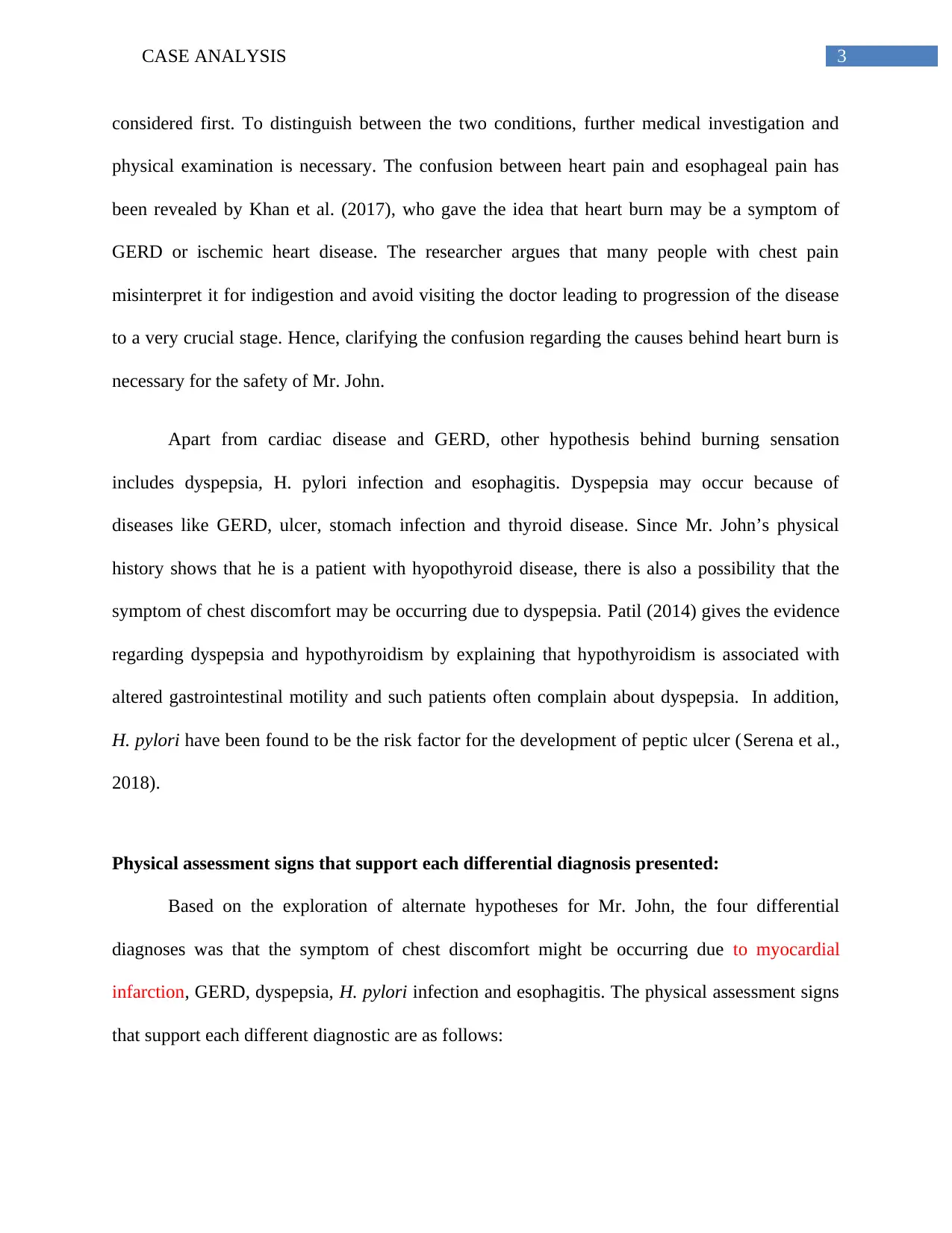
3CASE ANALYSIS
considered first. To distinguish between the two conditions, further medical investigation and
physical examination is necessary. The confusion between heart pain and esophageal pain has
been revealed by Khan et al. (2017), who gave the idea that heart burn may be a symptom of
GERD or ischemic heart disease. The researcher argues that many people with chest pain
misinterpret it for indigestion and avoid visiting the doctor leading to progression of the disease
to a very crucial stage. Hence, clarifying the confusion regarding the causes behind heart burn is
necessary for the safety of Mr. John.
Apart from cardiac disease and GERD, other hypothesis behind burning sensation
includes dyspepsia, H. pylori infection and esophagitis. Dyspepsia may occur because of
diseases like GERD, ulcer, stomach infection and thyroid disease. Since Mr. John’s physical
history shows that he is a patient with hyopothyroid disease, there is also a possibility that the
symptom of chest discomfort may be occurring due to dyspepsia. Patil (2014) gives the evidence
regarding dyspepsia and hypothyroidism by explaining that hypothyroidism is associated with
altered gastrointestinal motility and such patients often complain about dyspepsia. In addition,
H. pylori have been found to be the risk factor for the development of peptic ulcer (Serena et al.,
2018).
Physical assessment signs that support each differential diagnosis presented:
Based on the exploration of alternate hypotheses for Mr. John, the four differential
diagnoses was that the symptom of chest discomfort might be occurring due to myocardial
infarction, GERD, dyspepsia, H. pylori infection and esophagitis. The physical assessment signs
that support each different diagnostic are as follows:
considered first. To distinguish between the two conditions, further medical investigation and
physical examination is necessary. The confusion between heart pain and esophageal pain has
been revealed by Khan et al. (2017), who gave the idea that heart burn may be a symptom of
GERD or ischemic heart disease. The researcher argues that many people with chest pain
misinterpret it for indigestion and avoid visiting the doctor leading to progression of the disease
to a very crucial stage. Hence, clarifying the confusion regarding the causes behind heart burn is
necessary for the safety of Mr. John.
Apart from cardiac disease and GERD, other hypothesis behind burning sensation
includes dyspepsia, H. pylori infection and esophagitis. Dyspepsia may occur because of
diseases like GERD, ulcer, stomach infection and thyroid disease. Since Mr. John’s physical
history shows that he is a patient with hyopothyroid disease, there is also a possibility that the
symptom of chest discomfort may be occurring due to dyspepsia. Patil (2014) gives the evidence
regarding dyspepsia and hypothyroidism by explaining that hypothyroidism is associated with
altered gastrointestinal motility and such patients often complain about dyspepsia. In addition,
H. pylori have been found to be the risk factor for the development of peptic ulcer (Serena et al.,
2018).
Physical assessment signs that support each differential diagnosis presented:
Based on the exploration of alternate hypotheses for Mr. John, the four differential
diagnoses was that the symptom of chest discomfort might be occurring due to myocardial
infarction, GERD, dyspepsia, H. pylori infection and esophagitis. The physical assessment signs
that support each different diagnostic are as follows:
Paraphrase This Document
Need a fresh take? Get an instant paraphrase of this document with our AI Paraphraser
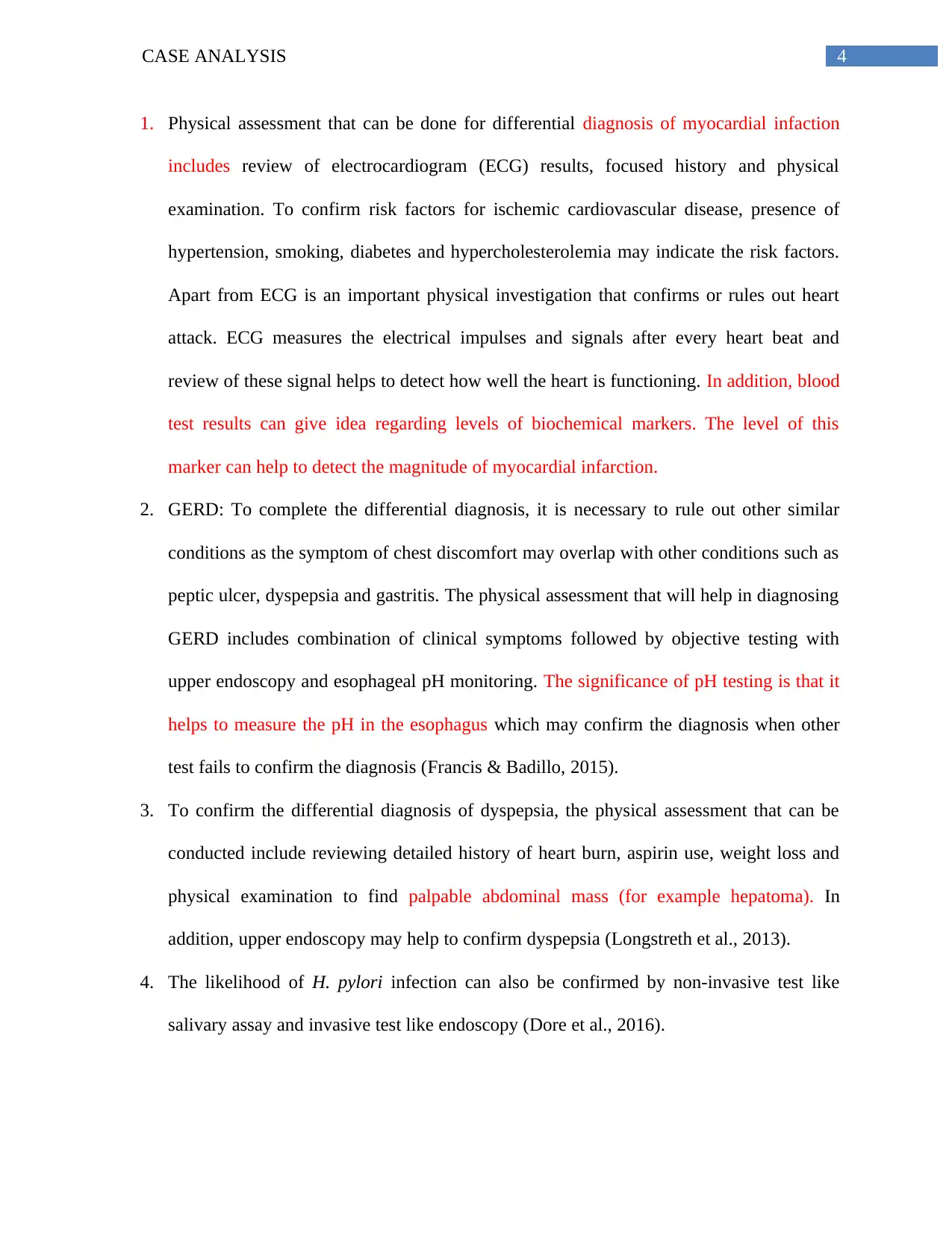
4CASE ANALYSIS
1. Physical assessment that can be done for differential diagnosis of myocardial infaction
includes review of electrocardiogram (ECG) results, focused history and physical
examination. To confirm risk factors for ischemic cardiovascular disease, presence of
hypertension, smoking, diabetes and hypercholesterolemia may indicate the risk factors.
Apart from ECG is an important physical investigation that confirms or rules out heart
attack. ECG measures the electrical impulses and signals after every heart beat and
review of these signal helps to detect how well the heart is functioning. In addition, blood
test results can give idea regarding levels of biochemical markers. The level of this
marker can help to detect the magnitude of myocardial infarction.
2. GERD: To complete the differential diagnosis, it is necessary to rule out other similar
conditions as the symptom of chest discomfort may overlap with other conditions such as
peptic ulcer, dyspepsia and gastritis. The physical assessment that will help in diagnosing
GERD includes combination of clinical symptoms followed by objective testing with
upper endoscopy and esophageal pH monitoring. The significance of pH testing is that it
helps to measure the pH in the esophagus which may confirm the diagnosis when other
test fails to confirm the diagnosis (Francis & Badillo, 2015).
3. To confirm the differential diagnosis of dyspepsia, the physical assessment that can be
conducted include reviewing detailed history of heart burn, aspirin use, weight loss and
physical examination to find palpable abdominal mass (for example hepatoma). In
addition, upper endoscopy may help to confirm dyspepsia (Longstreth et al., 2013).
4. The likelihood of H. pylori infection can also be confirmed by non-invasive test like
salivary assay and invasive test like endoscopy (Dore et al., 2016).
1. Physical assessment that can be done for differential diagnosis of myocardial infaction
includes review of electrocardiogram (ECG) results, focused history and physical
examination. To confirm risk factors for ischemic cardiovascular disease, presence of
hypertension, smoking, diabetes and hypercholesterolemia may indicate the risk factors.
Apart from ECG is an important physical investigation that confirms or rules out heart
attack. ECG measures the electrical impulses and signals after every heart beat and
review of these signal helps to detect how well the heart is functioning. In addition, blood
test results can give idea regarding levels of biochemical markers. The level of this
marker can help to detect the magnitude of myocardial infarction.
2. GERD: To complete the differential diagnosis, it is necessary to rule out other similar
conditions as the symptom of chest discomfort may overlap with other conditions such as
peptic ulcer, dyspepsia and gastritis. The physical assessment that will help in diagnosing
GERD includes combination of clinical symptoms followed by objective testing with
upper endoscopy and esophageal pH monitoring. The significance of pH testing is that it
helps to measure the pH in the esophagus which may confirm the diagnosis when other
test fails to confirm the diagnosis (Francis & Badillo, 2015).
3. To confirm the differential diagnosis of dyspepsia, the physical assessment that can be
conducted include reviewing detailed history of heart burn, aspirin use, weight loss and
physical examination to find palpable abdominal mass (for example hepatoma). In
addition, upper endoscopy may help to confirm dyspepsia (Longstreth et al., 2013).
4. The likelihood of H. pylori infection can also be confirmed by non-invasive test like
salivary assay and invasive test like endoscopy (Dore et al., 2016).

5CASE ANALYSIS
Prescribes diagnostic studies to evaluate hypotheses:
The prescribed diagnostics studies that evaluate each hypothesis are as follows:
1. The diagnostic study by Rosiek and Leksowski (2016) gives the idea that ECG is an
important assessment for the diagnosis of heart attack or acute coronary syndrome. It
supports that as ECG provides information of heart muscle damage, the diagnosis for a
heart attack can be confirmed. However, the study findings has good specificity as the
findings has been framed using the American Heart Guidelines for cardiopulmonary
resuscitation and emergency cardiovascular care.
2. The study by Francis and Badillo (2015) provides a comprehensive discussion on
etiology and diagnosis of GERD. The sensitivity and specificity of the study is
understood from explanation regarding steps and additional testing that can further
improve diagnostic results.
3. The study by Talley (2017) is a comprehensive diagnostic paper that analyzes the
epidemiology and pathogenesis of patients with dyspepsia. The specificity and sensitivity
of the diagnostic criteria has been defined by use of Rome III criteria which has a
diagnostic sensitivity of 61% and a specificity of 69%. Both are at sub-optimal level. The
Rome III criteria for functional dyspepsia consider presence of symptoms like epigastric
pain, early satiety and postgrandial fullness to detect dyspepsia (Talley, 2017).
4. Dore et al. (2016) used the Rome III criteria to evaluate symptoms of H. pylori infection.
This involved confirming symptoms using the tests like salivary assay, 13C-urea breath
test and the bacterial culture susceptibility test.
Patient and family inclusion to assist in diagnostic error avoidance:
Prescribes diagnostic studies to evaluate hypotheses:
The prescribed diagnostics studies that evaluate each hypothesis are as follows:
1. The diagnostic study by Rosiek and Leksowski (2016) gives the idea that ECG is an
important assessment for the diagnosis of heart attack or acute coronary syndrome. It
supports that as ECG provides information of heart muscle damage, the diagnosis for a
heart attack can be confirmed. However, the study findings has good specificity as the
findings has been framed using the American Heart Guidelines for cardiopulmonary
resuscitation and emergency cardiovascular care.
2. The study by Francis and Badillo (2015) provides a comprehensive discussion on
etiology and diagnosis of GERD. The sensitivity and specificity of the study is
understood from explanation regarding steps and additional testing that can further
improve diagnostic results.
3. The study by Talley (2017) is a comprehensive diagnostic paper that analyzes the
epidemiology and pathogenesis of patients with dyspepsia. The specificity and sensitivity
of the diagnostic criteria has been defined by use of Rome III criteria which has a
diagnostic sensitivity of 61% and a specificity of 69%. Both are at sub-optimal level. The
Rome III criteria for functional dyspepsia consider presence of symptoms like epigastric
pain, early satiety and postgrandial fullness to detect dyspepsia (Talley, 2017).
4. Dore et al. (2016) used the Rome III criteria to evaluate symptoms of H. pylori infection.
This involved confirming symptoms using the tests like salivary assay, 13C-urea breath
test and the bacterial culture susceptibility test.
Patient and family inclusion to assist in diagnostic error avoidance:
⊘ This is a preview!⊘
Do you want full access?
Subscribe today to unlock all pages.

Trusted by 1+ million students worldwide
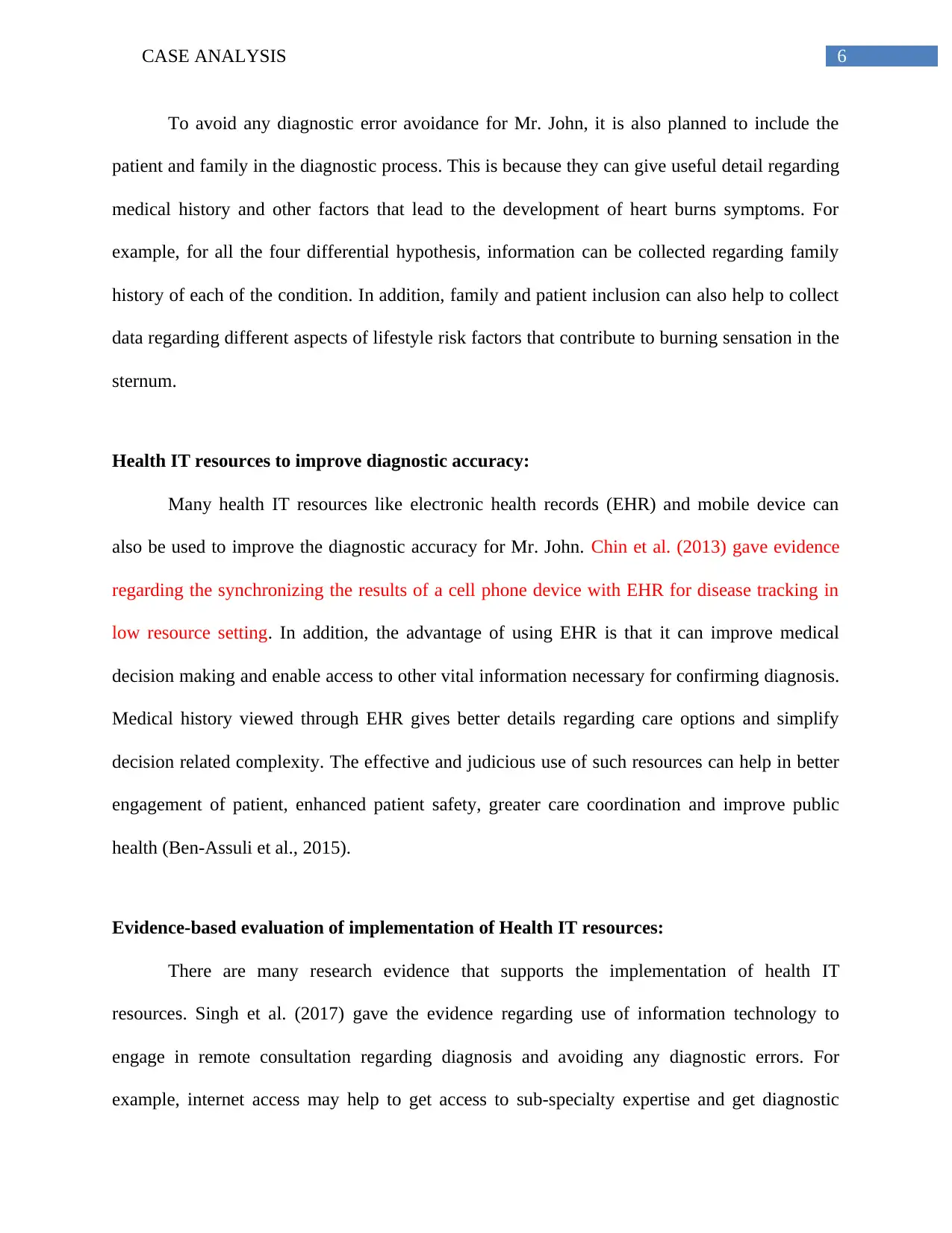
6CASE ANALYSIS
To avoid any diagnostic error avoidance for Mr. John, it is also planned to include the
patient and family in the diagnostic process. This is because they can give useful detail regarding
medical history and other factors that lead to the development of heart burns symptoms. For
example, for all the four differential hypothesis, information can be collected regarding family
history of each of the condition. In addition, family and patient inclusion can also help to collect
data regarding different aspects of lifestyle risk factors that contribute to burning sensation in the
sternum.
Health IT resources to improve diagnostic accuracy:
Many health IT resources like electronic health records (EHR) and mobile device can
also be used to improve the diagnostic accuracy for Mr. John. Chin et al. (2013) gave evidence
regarding the synchronizing the results of a cell phone device with EHR for disease tracking in
low resource setting. In addition, the advantage of using EHR is that it can improve medical
decision making and enable access to other vital information necessary for confirming diagnosis.
Medical history viewed through EHR gives better details regarding care options and simplify
decision related complexity. The effective and judicious use of such resources can help in better
engagement of patient, enhanced patient safety, greater care coordination and improve public
health (Ben-Assuli et al., 2015).
Evidence-based evaluation of implementation of Health IT resources:
There are many research evidence that supports the implementation of health IT
resources. Singh et al. (2017) gave the evidence regarding use of information technology to
engage in remote consultation regarding diagnosis and avoiding any diagnostic errors. For
example, internet access may help to get access to sub-specialty expertise and get diagnostic
To avoid any diagnostic error avoidance for Mr. John, it is also planned to include the
patient and family in the diagnostic process. This is because they can give useful detail regarding
medical history and other factors that lead to the development of heart burns symptoms. For
example, for all the four differential hypothesis, information can be collected regarding family
history of each of the condition. In addition, family and patient inclusion can also help to collect
data regarding different aspects of lifestyle risk factors that contribute to burning sensation in the
sternum.
Health IT resources to improve diagnostic accuracy:
Many health IT resources like electronic health records (EHR) and mobile device can
also be used to improve the diagnostic accuracy for Mr. John. Chin et al. (2013) gave evidence
regarding the synchronizing the results of a cell phone device with EHR for disease tracking in
low resource setting. In addition, the advantage of using EHR is that it can improve medical
decision making and enable access to other vital information necessary for confirming diagnosis.
Medical history viewed through EHR gives better details regarding care options and simplify
decision related complexity. The effective and judicious use of such resources can help in better
engagement of patient, enhanced patient safety, greater care coordination and improve public
health (Ben-Assuli et al., 2015).
Evidence-based evaluation of implementation of Health IT resources:
There are many research evidence that supports the implementation of health IT
resources. Singh et al. (2017) gave the evidence regarding use of information technology to
engage in remote consultation regarding diagnosis and avoiding any diagnostic errors. For
example, internet access may help to get access to sub-specialty expertise and get diagnostic
Paraphrase This Document
Need a fresh take? Get an instant paraphrase of this document with our AI Paraphraser

7CASE ANALYSIS
support. Hence, IT resource can facilitate detection of errors and promote diagnostic reasoning.
In addition, advanced IT-based diagnostic tools like mini-sized ultrasonocardiographic scanner
can detect congenital heart disease. Similar type of IT resource will be utilized in the context. El-
Kareh, Hasan and Schiff (2013) support that health information technology (HIT) is efficient
system that reduce the rate of incorrect diagnoses. Human related limitations are minimized by
the use of HIT tools. They not only help in information gathering but also in enhancing display
of information. Many tools and calculators have also emerged now to weight differential
diagnosis. This has been used for predicting pulmonary embolism, deep vein thrombosis and
many others. Embedded algorithms also exist for patient with myocardial infarction. Diagnostic
protocols embedded in electronic tools in hospitals also improve selection of diagnostic tests and
plan.
Pharmacologic interventions appropriate to each differential diagnosis:
Based on the estimation of different types of diagnosis for chest discomfort of Mr. John,
the following pharmacologic interventions will be effective for each differential diagnosis:
1. In case of the diagnosis of myocardial infarction and its role in leading to heart burn, the
pharmacological interventions that can treat Mr. John includes use of beta-blockers and
ACE inhibitors. Akbar and Richards (2018) give the evidence regarding the utility of beta
blockers in treating patients with myocardial infarction. In addition, ACE inhibitors can
play a vital role in decreasing the risk of future heart attack by blocking the action of the
protein that leads to narrowing of the blood vessels (Alderman et al., 2016).
2. For the differential diagnosis of acid reflux or GERD, the intervention that can help to
alleviate the symptom of Mr. John include changing lifestyle of patient by targeting
support. Hence, IT resource can facilitate detection of errors and promote diagnostic reasoning.
In addition, advanced IT-based diagnostic tools like mini-sized ultrasonocardiographic scanner
can detect congenital heart disease. Similar type of IT resource will be utilized in the context. El-
Kareh, Hasan and Schiff (2013) support that health information technology (HIT) is efficient
system that reduce the rate of incorrect diagnoses. Human related limitations are minimized by
the use of HIT tools. They not only help in information gathering but also in enhancing display
of information. Many tools and calculators have also emerged now to weight differential
diagnosis. This has been used for predicting pulmonary embolism, deep vein thrombosis and
many others. Embedded algorithms also exist for patient with myocardial infarction. Diagnostic
protocols embedded in electronic tools in hospitals also improve selection of diagnostic tests and
plan.
Pharmacologic interventions appropriate to each differential diagnosis:
Based on the estimation of different types of diagnosis for chest discomfort of Mr. John,
the following pharmacologic interventions will be effective for each differential diagnosis:
1. In case of the diagnosis of myocardial infarction and its role in leading to heart burn, the
pharmacological interventions that can treat Mr. John includes use of beta-blockers and
ACE inhibitors. Akbar and Richards (2018) give the evidence regarding the utility of beta
blockers in treating patients with myocardial infarction. In addition, ACE inhibitors can
play a vital role in decreasing the risk of future heart attack by blocking the action of the
protein that leads to narrowing of the blood vessels (Alderman et al., 2016).
2. For the differential diagnosis of acid reflux or GERD, the intervention that can help to
alleviate the symptom of Mr. John include changing lifestyle of patient by targeting
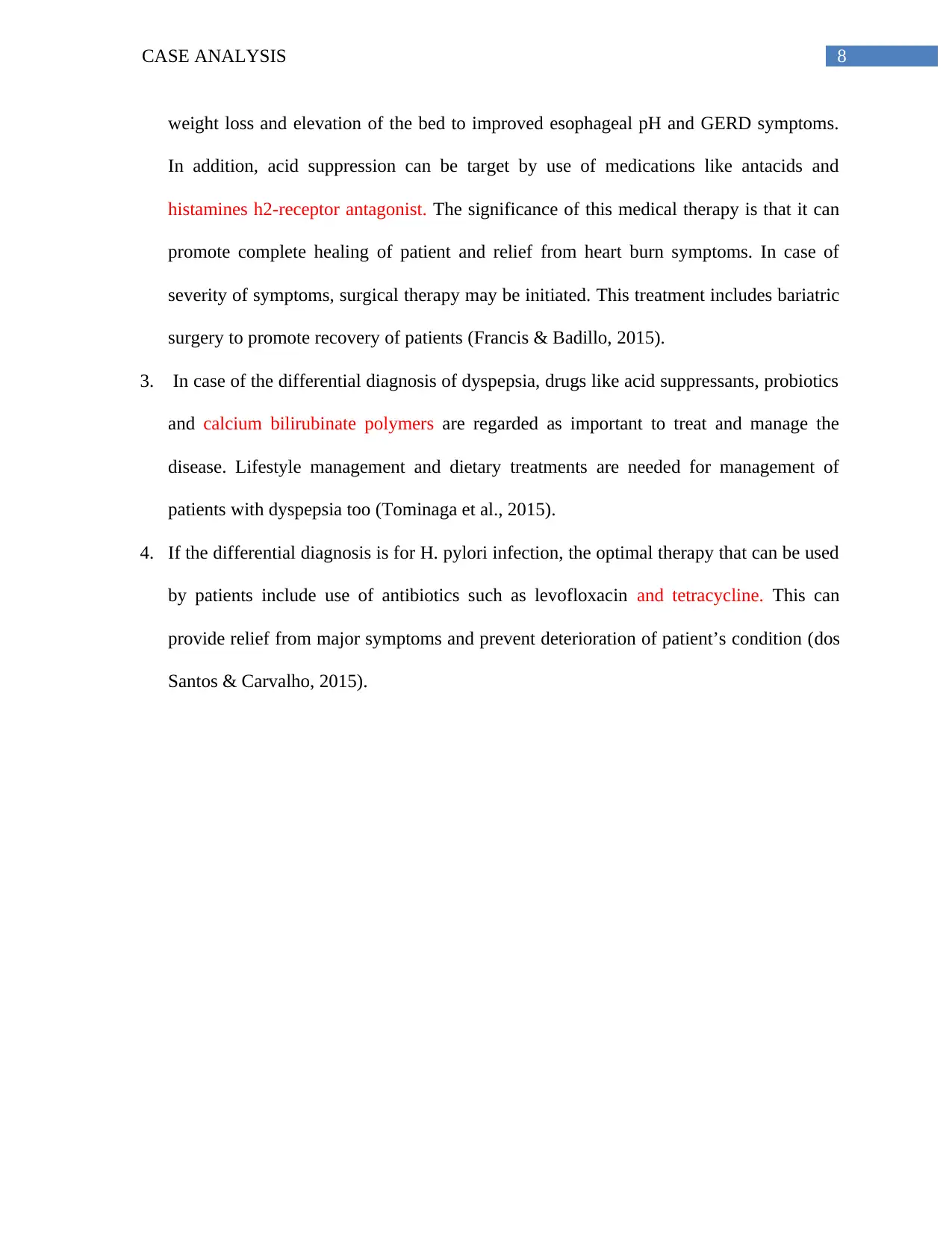
8CASE ANALYSIS
weight loss and elevation of the bed to improved esophageal pH and GERD symptoms.
In addition, acid suppression can be target by use of medications like antacids and
histamines h2-receptor antagonist. The significance of this medical therapy is that it can
promote complete healing of patient and relief from heart burn symptoms. In case of
severity of symptoms, surgical therapy may be initiated. This treatment includes bariatric
surgery to promote recovery of patients (Francis & Badillo, 2015).
3. In case of the differential diagnosis of dyspepsia, drugs like acid suppressants, probiotics
and calcium bilirubinate polymers are regarded as important to treat and manage the
disease. Lifestyle management and dietary treatments are needed for management of
patients with dyspepsia too (Tominaga et al., 2015).
4. If the differential diagnosis is for H. pylori infection, the optimal therapy that can be used
by patients include use of antibiotics such as levofloxacin and tetracycline. This can
provide relief from major symptoms and prevent deterioration of patient’s condition (dos
Santos & Carvalho, 2015).
weight loss and elevation of the bed to improved esophageal pH and GERD symptoms.
In addition, acid suppression can be target by use of medications like antacids and
histamines h2-receptor antagonist. The significance of this medical therapy is that it can
promote complete healing of patient and relief from heart burn symptoms. In case of
severity of symptoms, surgical therapy may be initiated. This treatment includes bariatric
surgery to promote recovery of patients (Francis & Badillo, 2015).
3. In case of the differential diagnosis of dyspepsia, drugs like acid suppressants, probiotics
and calcium bilirubinate polymers are regarded as important to treat and manage the
disease. Lifestyle management and dietary treatments are needed for management of
patients with dyspepsia too (Tominaga et al., 2015).
4. If the differential diagnosis is for H. pylori infection, the optimal therapy that can be used
by patients include use of antibiotics such as levofloxacin and tetracycline. This can
provide relief from major symptoms and prevent deterioration of patient’s condition (dos
Santos & Carvalho, 2015).
⊘ This is a preview!⊘
Do you want full access?
Subscribe today to unlock all pages.

Trusted by 1+ million students worldwide

9CASE ANALYSIS
References:
Akbar, S., & Richards, J. R. (2018). Beta-blockers for heart failure: Pharmacology, relevance,
and justification. In Beta-Blockers: Physiological, Pharmacological and Therapeutic
Implications (pp. 1-44). Nova Science Publishers, Inc.. Retrieved from:
https://ucdavis.pure.elsevier.com/en/publications/beta-blockers-for-heart-failure-
pharmacology-relevance-and-justif
Alderman, M. H., Davis, B. R., Piller, L. B., Ford, C. E., Baraniuk, M. S., Pressel, S. L., ... &
Oparil, S. (2016). Should antihypertensive treatment recommendations differ in patients
with and without coronary heart disease?(from the antihypertensive and lipid-lowering
treatment to prevent heart attack trial [ALLHAT]). The American journal of
cardiology, 117(1), 105-115. doi: 10.1016/j.amjcard.2015.10.012
Ben-Assuli, O., Sagi, D., Leshno, M., Ironi, A., & Ziv, A. (2015). Improving diagnostic accuracy
using EHR in emergency departments: A simulation-based study. Journal of biomedical
informatics, 55, 31-40. https://doi.org/10.1016/j.jbi.2015.03.004
Chin, C. D., Cheung, Y. K., Laksanasopin, T., Modena, M. M., Chin, S. Y., Sridhara, A. A., ... &
Karita, E. (2013). Mobile device for disease diagnosis and data tracking in resource-
limited settings. Clinical chemistry, 59(4), 629-640. Doi: 10.1373/clinchem.2012.199596
Dore, M. P., Pes, G. M., Bassotti, G., & Usai-Satta, P. (2016). Dyspepsia: when and how to test
for Helicobacter pylori infection. Gastroenterology research and practice, 2016. DOI:
10.1155/2016/8463614
References:
Akbar, S., & Richards, J. R. (2018). Beta-blockers for heart failure: Pharmacology, relevance,
and justification. In Beta-Blockers: Physiological, Pharmacological and Therapeutic
Implications (pp. 1-44). Nova Science Publishers, Inc.. Retrieved from:
https://ucdavis.pure.elsevier.com/en/publications/beta-blockers-for-heart-failure-
pharmacology-relevance-and-justif
Alderman, M. H., Davis, B. R., Piller, L. B., Ford, C. E., Baraniuk, M. S., Pressel, S. L., ... &
Oparil, S. (2016). Should antihypertensive treatment recommendations differ in patients
with and without coronary heart disease?(from the antihypertensive and lipid-lowering
treatment to prevent heart attack trial [ALLHAT]). The American journal of
cardiology, 117(1), 105-115. doi: 10.1016/j.amjcard.2015.10.012
Ben-Assuli, O., Sagi, D., Leshno, M., Ironi, A., & Ziv, A. (2015). Improving diagnostic accuracy
using EHR in emergency departments: A simulation-based study. Journal of biomedical
informatics, 55, 31-40. https://doi.org/10.1016/j.jbi.2015.03.004
Chin, C. D., Cheung, Y. K., Laksanasopin, T., Modena, M. M., Chin, S. Y., Sridhara, A. A., ... &
Karita, E. (2013). Mobile device for disease diagnosis and data tracking in resource-
limited settings. Clinical chemistry, 59(4), 629-640. Doi: 10.1373/clinchem.2012.199596
Dore, M. P., Pes, G. M., Bassotti, G., & Usai-Satta, P. (2016). Dyspepsia: when and how to test
for Helicobacter pylori infection. Gastroenterology research and practice, 2016. DOI:
10.1155/2016/8463614
Paraphrase This Document
Need a fresh take? Get an instant paraphrase of this document with our AI Paraphraser
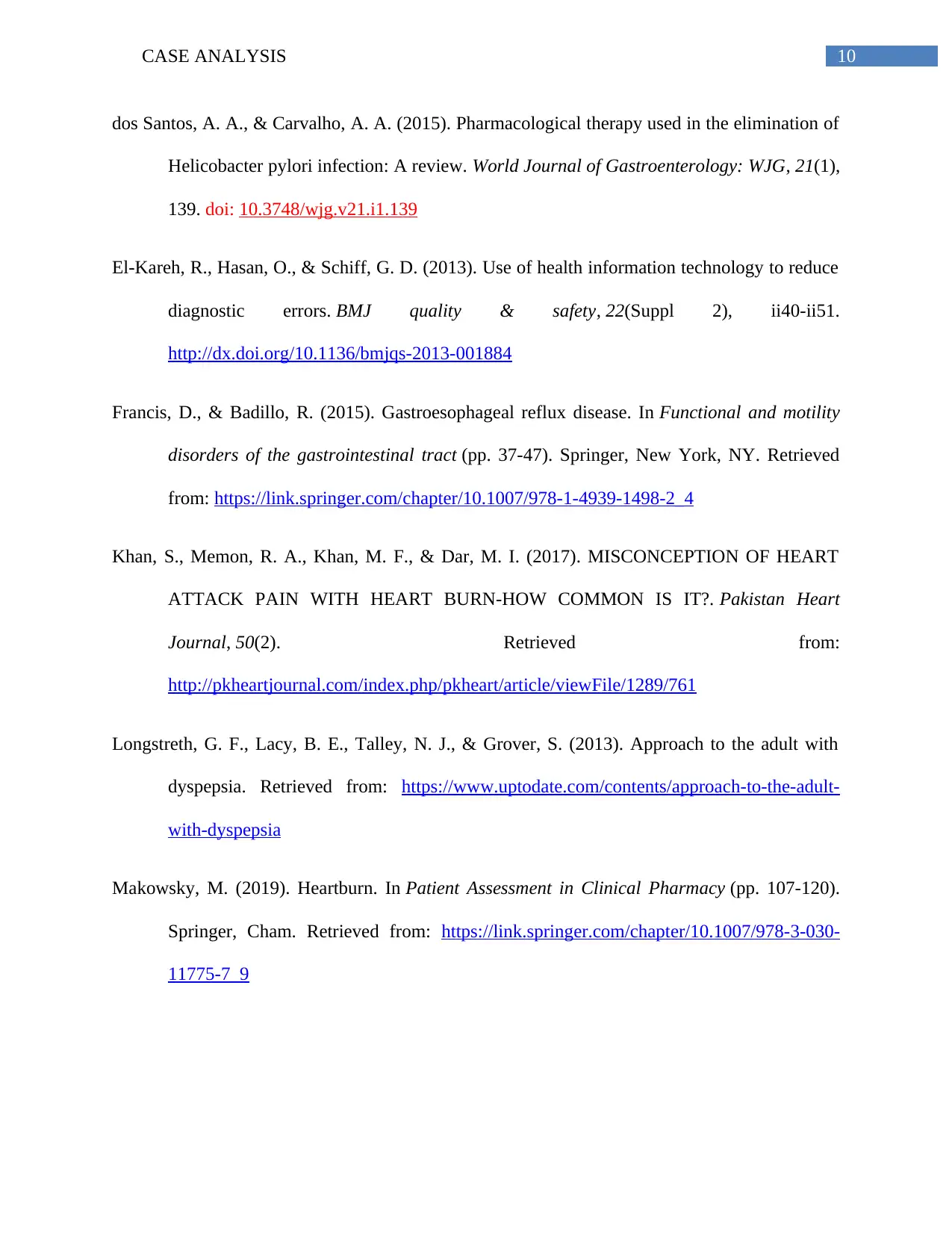
10CASE ANALYSIS
dos Santos, A. A., & Carvalho, A. A. (2015). Pharmacological therapy used in the elimination of
Helicobacter pylori infection: A review. World Journal of Gastroenterology: WJG, 21(1),
139. doi: 10.3748/wjg.v21.i1.139
El-Kareh, R., Hasan, O., & Schiff, G. D. (2013). Use of health information technology to reduce
diagnostic errors. BMJ quality & safety, 22(Suppl 2), ii40-ii51.
http://dx.doi.org/10.1136/bmjqs-2013-001884
Francis, D., & Badillo, R. (2015). Gastroesophageal reflux disease. In Functional and motility
disorders of the gastrointestinal tract (pp. 37-47). Springer, New York, NY. Retrieved
from: https://link.springer.com/chapter/10.1007/978-1-4939-1498-2_4
Khan, S., Memon, R. A., Khan, M. F., & Dar, M. I. (2017). MISCONCEPTION OF HEART
ATTACK PAIN WITH HEART BURN-HOW COMMON IS IT?. Pakistan Heart
Journal, 50(2). Retrieved from:
http://pkheartjournal.com/index.php/pkheart/article/viewFile/1289/761
Longstreth, G. F., Lacy, B. E., Talley, N. J., & Grover, S. (2013). Approach to the adult with
dyspepsia. Retrieved from: https://www.uptodate.com/contents/approach-to-the-adult-
with-dyspepsia
Makowsky, M. (2019). Heartburn. In Patient Assessment in Clinical Pharmacy (pp. 107-120).
Springer, Cham. Retrieved from: https://link.springer.com/chapter/10.1007/978-3-030-
11775-7_9
dos Santos, A. A., & Carvalho, A. A. (2015). Pharmacological therapy used in the elimination of
Helicobacter pylori infection: A review. World Journal of Gastroenterology: WJG, 21(1),
139. doi: 10.3748/wjg.v21.i1.139
El-Kareh, R., Hasan, O., & Schiff, G. D. (2013). Use of health information technology to reduce
diagnostic errors. BMJ quality & safety, 22(Suppl 2), ii40-ii51.
http://dx.doi.org/10.1136/bmjqs-2013-001884
Francis, D., & Badillo, R. (2015). Gastroesophageal reflux disease. In Functional and motility
disorders of the gastrointestinal tract (pp. 37-47). Springer, New York, NY. Retrieved
from: https://link.springer.com/chapter/10.1007/978-1-4939-1498-2_4
Khan, S., Memon, R. A., Khan, M. F., & Dar, M. I. (2017). MISCONCEPTION OF HEART
ATTACK PAIN WITH HEART BURN-HOW COMMON IS IT?. Pakistan Heart
Journal, 50(2). Retrieved from:
http://pkheartjournal.com/index.php/pkheart/article/viewFile/1289/761
Longstreth, G. F., Lacy, B. E., Talley, N. J., & Grover, S. (2013). Approach to the adult with
dyspepsia. Retrieved from: https://www.uptodate.com/contents/approach-to-the-adult-
with-dyspepsia
Makowsky, M. (2019). Heartburn. In Patient Assessment in Clinical Pharmacy (pp. 107-120).
Springer, Cham. Retrieved from: https://link.springer.com/chapter/10.1007/978-3-030-
11775-7_9
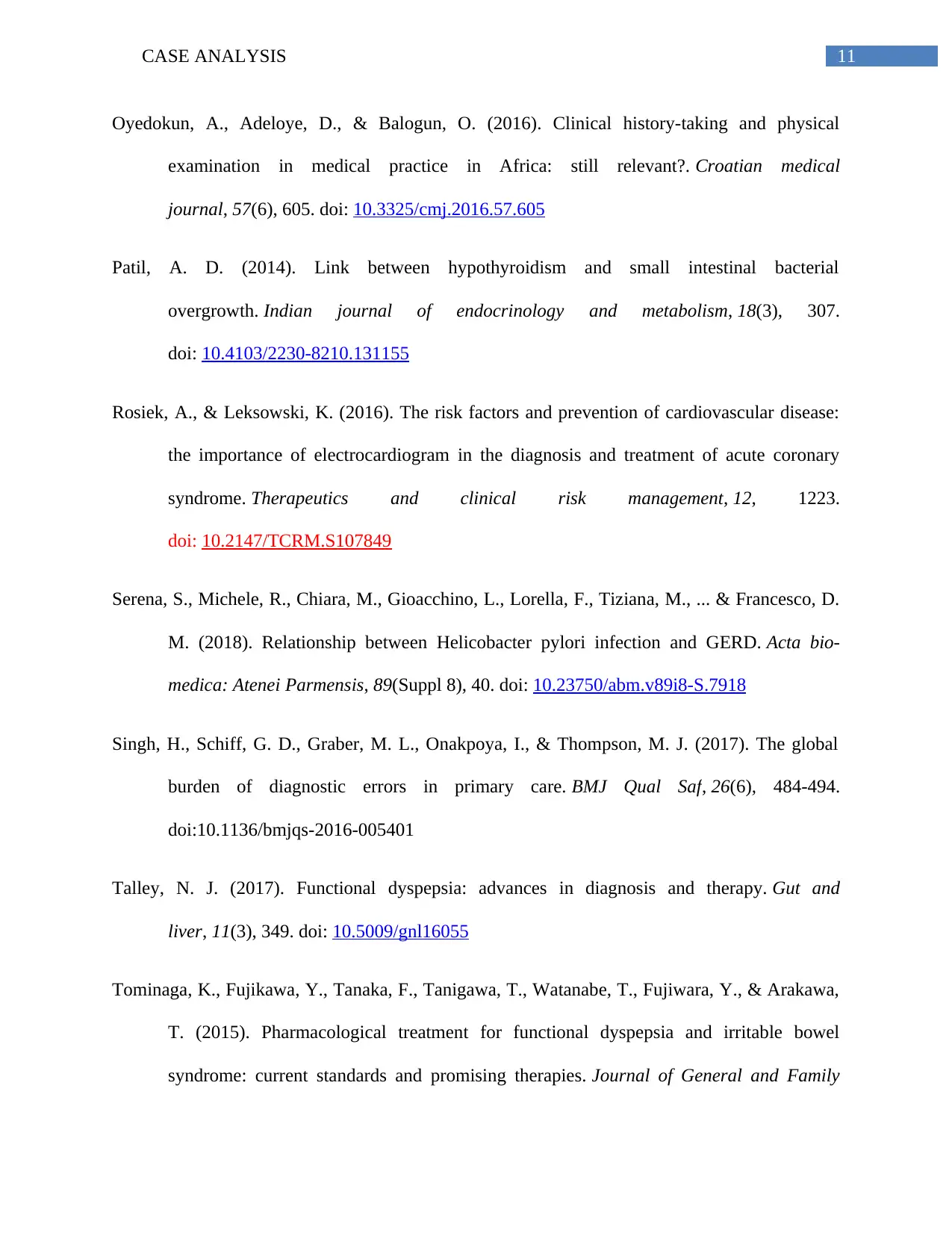
11CASE ANALYSIS
Oyedokun, A., Adeloye, D., & Balogun, O. (2016). Clinical history-taking and physical
examination in medical practice in Africa: still relevant?. Croatian medical
journal, 57(6), 605. doi: 10.3325/cmj.2016.57.605
Patil, A. D. (2014). Link between hypothyroidism and small intestinal bacterial
overgrowth. Indian journal of endocrinology and metabolism, 18(3), 307.
doi: 10.4103/2230-8210.131155
Rosiek, A., & Leksowski, K. (2016). The risk factors and prevention of cardiovascular disease:
the importance of electrocardiogram in the diagnosis and treatment of acute coronary
syndrome. Therapeutics and clinical risk management, 12, 1223.
doi: 10.2147/TCRM.S107849
Serena, S., Michele, R., Chiara, M., Gioacchino, L., Lorella, F., Tiziana, M., ... & Francesco, D.
M. (2018). Relationship between Helicobacter pylori infection and GERD. Acta bio-
medica: Atenei Parmensis, 89(Suppl 8), 40. doi: 10.23750/abm.v89i8-S.7918
Singh, H., Schiff, G. D., Graber, M. L., Onakpoya, I., & Thompson, M. J. (2017). The global
burden of diagnostic errors in primary care. BMJ Qual Saf, 26(6), 484-494.
doi:10.1136/bmjqs-2016-005401
Talley, N. J. (2017). Functional dyspepsia: advances in diagnosis and therapy. Gut and
liver, 11(3), 349. doi: 10.5009/gnl16055
Tominaga, K., Fujikawa, Y., Tanaka, F., Tanigawa, T., Watanabe, T., Fujiwara, Y., & Arakawa,
T. (2015). Pharmacological treatment for functional dyspepsia and irritable bowel
syndrome: current standards and promising therapies. Journal of General and Family
Oyedokun, A., Adeloye, D., & Balogun, O. (2016). Clinical history-taking and physical
examination in medical practice in Africa: still relevant?. Croatian medical
journal, 57(6), 605. doi: 10.3325/cmj.2016.57.605
Patil, A. D. (2014). Link between hypothyroidism and small intestinal bacterial
overgrowth. Indian journal of endocrinology and metabolism, 18(3), 307.
doi: 10.4103/2230-8210.131155
Rosiek, A., & Leksowski, K. (2016). The risk factors and prevention of cardiovascular disease:
the importance of electrocardiogram in the diagnosis and treatment of acute coronary
syndrome. Therapeutics and clinical risk management, 12, 1223.
doi: 10.2147/TCRM.S107849
Serena, S., Michele, R., Chiara, M., Gioacchino, L., Lorella, F., Tiziana, M., ... & Francesco, D.
M. (2018). Relationship between Helicobacter pylori infection and GERD. Acta bio-
medica: Atenei Parmensis, 89(Suppl 8), 40. doi: 10.23750/abm.v89i8-S.7918
Singh, H., Schiff, G. D., Graber, M. L., Onakpoya, I., & Thompson, M. J. (2017). The global
burden of diagnostic errors in primary care. BMJ Qual Saf, 26(6), 484-494.
doi:10.1136/bmjqs-2016-005401
Talley, N. J. (2017). Functional dyspepsia: advances in diagnosis and therapy. Gut and
liver, 11(3), 349. doi: 10.5009/gnl16055
Tominaga, K., Fujikawa, Y., Tanaka, F., Tanigawa, T., Watanabe, T., Fujiwara, Y., & Arakawa,
T. (2015). Pharmacological treatment for functional dyspepsia and irritable bowel
syndrome: current standards and promising therapies. Journal of General and Family
⊘ This is a preview!⊘
Do you want full access?
Subscribe today to unlock all pages.

Trusted by 1+ million students worldwide
1 out of 13
Related Documents
Your All-in-One AI-Powered Toolkit for Academic Success.
+13062052269
info@desklib.com
Available 24*7 on WhatsApp / Email
![[object Object]](/_next/static/media/star-bottom.7253800d.svg)
Unlock your academic potential
Copyright © 2020–2025 A2Z Services. All Rights Reserved. Developed and managed by ZUCOL.





